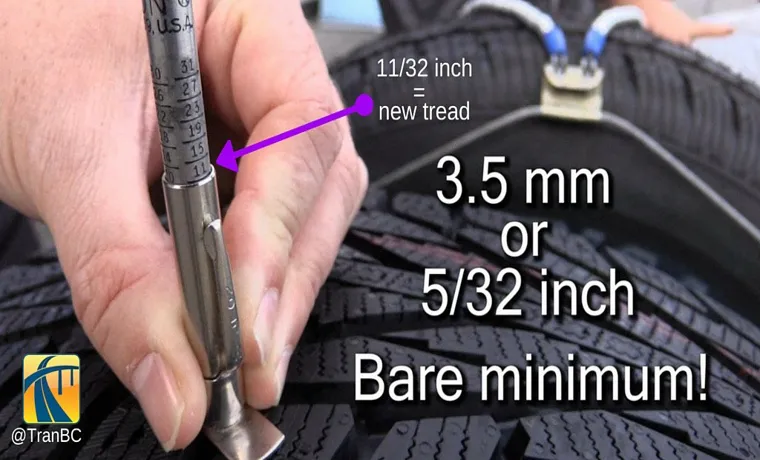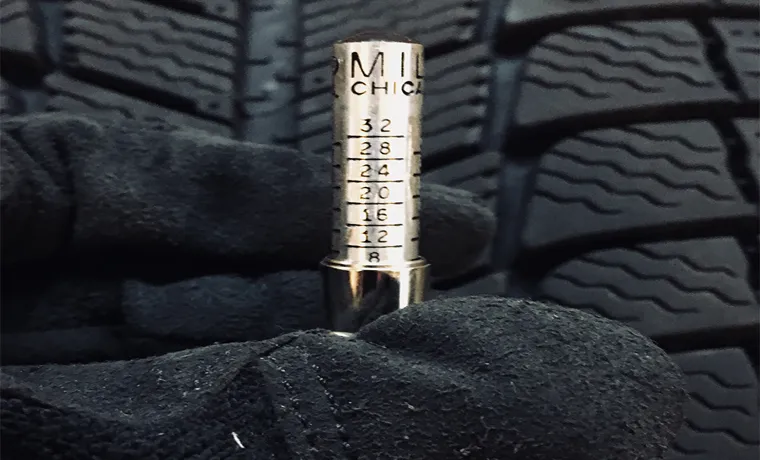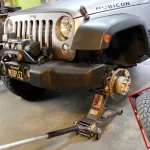When it comes to ensuring the safety and performance of your vehicle, monitoring tire wear is crucial. One of the most effective tools for measuring tire tread depth is a tire depth gauge. However, for those who are new to the world of auto maintenance, using a tire depth gauge can seem like a daunting task.
That’s why we’ve created this guide on how to read tire depth gauge with easy-to-follow instructions that will help you keep your vehicle’s tires in top condition. So, let’s dive in and explore the different aspects of using a tire depth gauge to accurately measure your tire’s tread depth.
Table of Contents
What is a Tire Depth Gauge?
A tire depth gauge is a tool used to measure the remaining tread depth of a tire. It’s an essential tool for ensuring the safety of your vehicle, as tires with low tread depth can lead to reduced traction and stability on the road. You can’t always tell by just looking at a tire whether it’s worn down or not, which is where the tire depth gauge comes in.
To use a tire depth gauge, press it up against the tire in the lowest point of the tread groove and read the measurement. The measurement will be in millimeters or inches and will tell you how much tread depth is remaining. It’s important to measure in multiple areas across the length of the tire for accuracy.
Remember to replace your tires when the tread depth is too low to ensure the safety of yourself and others on the road. With this information, you can now confidently read a tire depth gauge and ensure the safety of your vehicle.
Definition and Importance
A tire depth gauge is a tool that measures the depth of your tire treads. It is a small handheld device that can provide an accurate measurement of your tire’s tread depth to ensure that your tires meet the safety standards. Checking your tire depth regularly with a tire depth gauge is crucial because it helps you determine if your tires are worn out and need to be replaced.
This is important because the tire tread depth significantly affects your car’s performance, such as the grip and handling of the vehicle, especially in wet or slippery conditions. The deeper the tread, the better traction your tires have, reducing the risk of accidents. Therefore, investing in a tire depth gauge or having one handy in your car is a wise decision to ensure safety, and the longevity of your tires.

Types of Tire Depth Gauges
A tire depth gauge is a tool used to measure the depth of a tire’s tread. It is a crucial piece of equipment for anyone who takes their road safety seriously. Without sufficient tread, a tire can lose its ability to grip the road, making it harder to control and increasing the risk of accidents.
There are various types of tire depth gauges available on the market that cater to different situations. Some are manual, where you simply press the gauge onto the tire, while others are digital, which provide precise readings within seconds. There are also sophisticated laser measurement gauges that can produce even more accurate results.
Overall, regardless of the type you choose, a tire depth gauge is an essential tool that ensures your tires are safe and ready for the road.
How to Use a Tire Depth Gauge
Knowing how to read a tire depth gauge is essential in ensuring the safety and functionality of your car’s tires. The first step is to make sure the tire is cold, as hot tires will produce inaccurate readings. Next, locate the gauge’s measuring probe and insert it into the tire’s tread grooves.
Make sure to measure several points across the tire to get an accurate average reading. The gauge’s display will typically show a measurement in 32nds of an inch or millimeters. If the measurement is below the recommended minimum tread depth, it’s time to replace the tire.
Keep in mind, a tire with low tread depth may have difficulty gripping the road, especially in wet or slippery conditions, which can lead to dangerous accidents. By regularly measuring the tire’s tread depth, you can ensure your tires are safe and provide optimal performance for your vehicle.
Step-by-Step Guide
Using a tire depth gauge may seem like a daunting task, but it’s actually quite simple and essential to maintaining your vehicle’s safety. To begin, identify the spot on your tire with the most wear and tear. Insert the gauge’s probe into the groove of your tire and press down until the base of the gauge is flush with the tire’s surface.
The gauge will then provide a measurement of the remaining tread in either millimeters or 32nds of an inch. Be sure to check the tread depth in multiple spots, including the outer, middle, and inner portions of your tire, as well as across the width of the tire. Compare the measurement to your tire’s recommended depth, typically between 4/32 inch and 6/32 inch, to determine if it’s time for a replacement tire.
Don’t forget to clean the gauge after each use to ensure accuracy! Using a tire depth gauge is a straightforward process that can help keep you and your passengers safe on the road.
Tips for Accurate Readings
When it comes to maintaining your vehicle, checking your tire tread depth is a crucial aspect of ensuring your safety on the road. A tire depth gauge can accurately measure the depth of your tread, but it’s essential to know the steps to get an accurate reading. Firstly, make sure your tire is cool and not recently driven.
Place the gauge into the shallowest part of the tread, as this is where the tire tends to wear out first. Apply pressure onto the gauge until it stops and take note of the reading displayed. Repeat this process around the tire and measure at least three spots across the tread.
The average reading represents your tire’s tread depth, and if it measures below 2/32″, it’s time to replace the tire. Remember to replace your tires routinely, as worn-out tires reduce your vehicle’s traction and increase the risk of accidents. By regularly checking the depth of your tire tread, you can maintain optimal safety while driving, which should always be a top priority.
Common Mistakes to Avoid
Using a tire depth gauge may seem like a simple task, but there are some common mistakes to avoid to ensure accurate results. One of the most significant mistakes that people make when using a tire depth gauge is not using it correctly. Before using the gauge, ensure that the tire is clean and free from any debris that may affect the reading.
Additionally, make sure that the gauge is placed at the center of the tread groove to get an accurate measurement. Another mistake that people often make is relying solely on visual inspection to assess tire wear. However, eyeballing the tire may lead to an incorrect assumption of the depth, which may ultimately lead to unsafe driving conditions.
Therefore, using a tire depth gauge is crucial to ensure that car safety is not compromised. By knowing how to properly use a tire depth gauge, you can extend the life of your tires and avoid the risk of accidents caused by worn out tires.
What Do the Measurements Mean?
When it comes to understanding how to read tire depth gauge measurements, it can be a bit confusing at first. The measurements on the gauge represent the depth of the tire tread, which is the portion that makes contact with the road. This is important because the more worn down the tread, the less grip the tire has which can be dangerous, especially in wet or snowy conditions.
The measurement on the gauge is typically in millimeters, and the minimum legal tire tread depth is 6mm in most countries. To use the gauge, simply place it perpendicular to the tire tread and press down enough to ensure the gauge is seated.
Then, you can read the measurement directly off of the gauge. Keep in mind that it’s always a good idea to check the tire depth regularly and replace tires when they reach the minimum legal tread depth to ensure the safety of yourself and others on the road. By using a tire depth gauge correctly, you can ensure your tires are in top condition and have the grip you need for safe driving.
Understanding Tire Tread Wear
Tire tread wear is a common issue that can seriously affect your driving experience, handling, and safety on the road. Understanding what the various measurements mean and how to interpret them is crucial in ensuring your tires are in good condition and performing optimally. When you look at a tire’s tread wear rating, it refers to the tire’s durability and expected lifespan.
Typically, a tire with a higher tread wear rating will last longer than one with a lower rating. Tread depth, on the other hand, is a measurement of how much tread remains on a tire. The legal minimum tread depth is 2/32 of an inch, but for optimal traction and control, it’s recommended to replace tires when the tread depth reaches 4/32 of an inch or less.
Finally, tire aging is a critical factor to take into consideration, as a tire’s rubber compounds can deteriorate over time, particularly if stored improperly. Therefore, it’s essential to inspect your tires regularly, including checking the tread wear and other measurements, and having a professional replace them when necessary to ensure your safety on the road.
How to Identify Tire Wear Patterns
Identifying Tire Wear Patterns can save you from a lot of trouble in the long run. It not only affects the overall performance of the car but also your safety. Tires can reveal a lot about your vehicle’s health, like irregular, diagonal tread wear pattern suggests a camber issue, while feathered wear patterns indicate other problems such as toe or caster misalignment.
The measurements on your tire(s) can help you determine the type of wear pattern and its root cause. They identify the depth of the tread on each tire, which becomes really vital when you need to replace them, as tires with low tread depth can result in reduced road grip, hydroplaning, and even blowout risks. Understanding these measurements help you replace tires at the right time, save money, and save lives.
When to Replace your Tires?
Knowing when to replace your tires is essential for ensuring your safety on the road. One way to determine if your tires need to be replaced is by using a tire depth gauge. This small tool measures the depth of the tire tread, which is important for maintaining traction and grip on the road.
A tire depth gauge works by placing the tool in the tread grooves and reading the measurement on the gauge. If the tire tread depth is less than 2/32 of an inch, it’s time to replace the tire. Another way to determine if your tires need to be replaced is by looking for signs of wear and tear, such as cracks or bulges on the tire sidewall.
If you notice any of these signs, it’s important to replace your tires as soon as possible to ensure your safety on the road. So, don’t forget to check your tires’ tread depth regularly and replace them when needed to ensure you have a safe and comfortable ride.
Tire Tread Depth Requirements by Law
Tire tread depth requirements by law can help keep you safe on the roads and avoid a costly ticket. But when should you replace your tires? The answer depends on a few factors, but generally speaking, you should replace your tires when the tread depth reaches 2/32 of an inch or less. This is the minimum tread depth requirement by law.
However, it’s always a good idea to replace your tires before they reach this limit. Tires with more tread provide better traction, handling, and braking performance. You can check your tire tread depth using a penny or a tire depth gauge.
Simply insert the penny with Lincoln’s head upside-down into the tread groove. If you can see the top of Lincoln’s head, it’s time to replace your tires. Remember, proper tire maintenance is crucial for your safety and the safety of others on the road.
Don’t wait until it’s too late – keep an eye on your tires and replace them when necessary.
Signs of Tire Wear and Tear
Tire wear and tear is a normal part of vehicle ownership and it’s essential to know when it’s time to replace your tires. One of the signs of tire wear is tread depth, which is the measure of the distance between the tire’s surface and the groove. Over time, the treads begin to wear down, and when they reach below 2/32 of an inch, it’s time to replace them.
Another indicator of tire wear is cracking or bulging on the sidewall, which indicates that the tire has reached the end of its lifespan. Uneven wear is also a sign that something is wrong with your vehicle, such as incorrect tire pressure or a misaligned suspension. Finally, if you notice your car pulling to one side or difficulty maintaining traction on wet or slippery surfaces, it’s time to get your tires checked.
By paying attention to these signs of tire wear, you can ensure your safety on the road and avoid costly repairs down the line. So always keep an eye on your tires, and if you notice any of these signs, it’s time to get them replaced.
Benefits of Regular Tire Maintenance
Regular maintenance of your car tires is crucial for ensuring safe and smooth driving experience. But how do you know when it’s time to replace your tires? One way to do so is to check for signs of wear and tear such as cracks, punctures or uneven tread depth. Another indicator is the age of your tires; typically, they should be replaced every 6 years or 50,000 miles, whichever comes first.
Failing to replace worn-out or old tires can increase your risk of accidents on the road. Not only that, but it can also lead to reduced fuel efficiency and costly repairs in the long run. To avoid these potential problems, make sure to have your tires checked regularly by a professional and replace them when necessary.
It’s always better to be safe than sorry! So, keep in mind that tire maintenance should never be taken lightly for the safety of you and your family while driving.
Conclusion
Reading a tire depth gauge may seem daunting at first, but with a little practice and patience, it’s not rocket science. Remember, the deeper the tread, the better the grip. And if you find yourself struggling, just imagine the gauge as a tiny tire ruler, ready to help you measure up to the competition.
So go ahead, grab your tire depth gauge and show those tires who’s boss.”
FAQs
What is a tire depth gauge and how does it work?
A tire depth gauge is a tool used to measure the depth of tire treads. To use it, simply place the gauge on the tire tread and make sure it rests flat, then read the measurement from the gauge.
Why is it important to regularly measure tire tread depth?
Measuring tire tread depth is important because tires with low tread depth are more likely to hydroplane on wet roads and have less traction, which can lead to accidents.
How often should I measure my tire tread depth?
You should measure your tire tread depth at least once every six months to ensure that your tires are safe to drive on.
What is the minimum tire tread depth required by law?
In most states, the minimum tire tread depth required by law is 2/32 of an inch. However, it is recommended to replace tires when they reach 4/32 of an inch to ensure safety.
Can I use a coin to measure tire tread depth?
Yes, you can use a coin to measure tire tread depth. Place a penny upside down in the tire groove and if you can see the top of Lincoln’s head, it is time to replace your tires.
Can I measure tire tread depth on my own or should I go to a mechanic?
You can measure tire tread depth on your own with a tire depth gauge or a coin, but if you are unsure or uncomfortable doing it yourself, it is recommended to have a mechanic check your tire tread depth.
What are some signs that my tires may need to be replaced?
Some signs that your tires may need to be replaced include low tire tread depth, visible cracks or bulges on the tire, uneven tread wear, and vibrations while driving.



